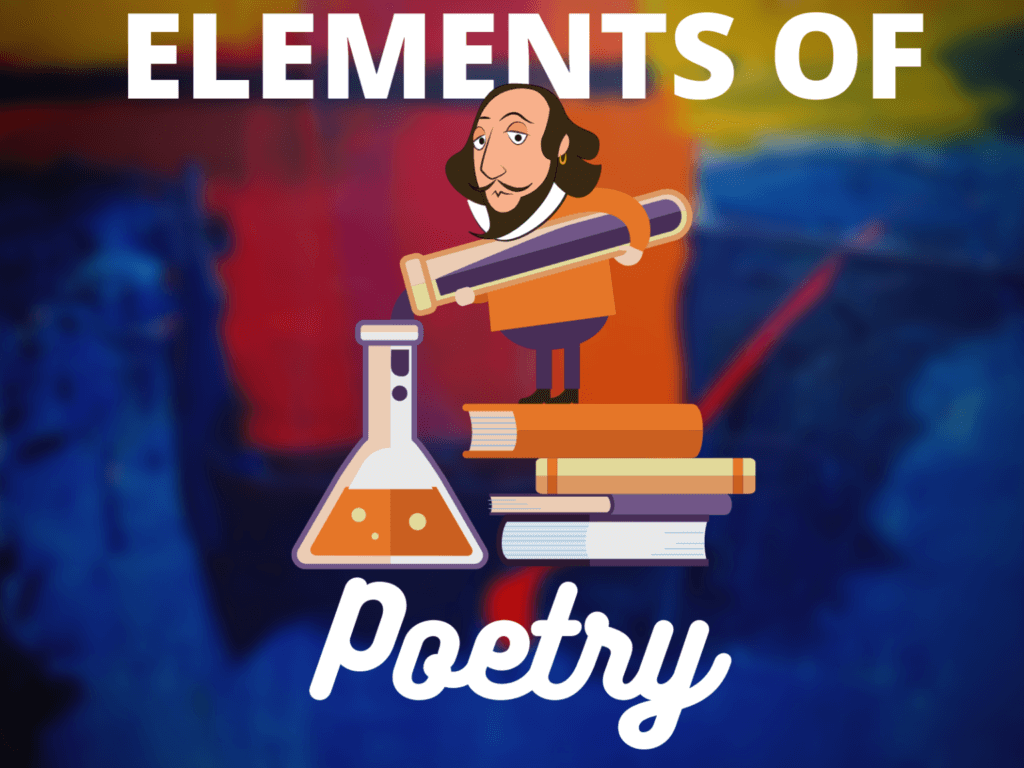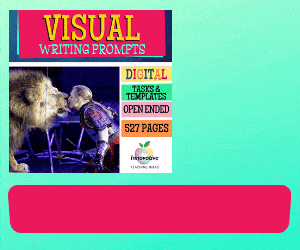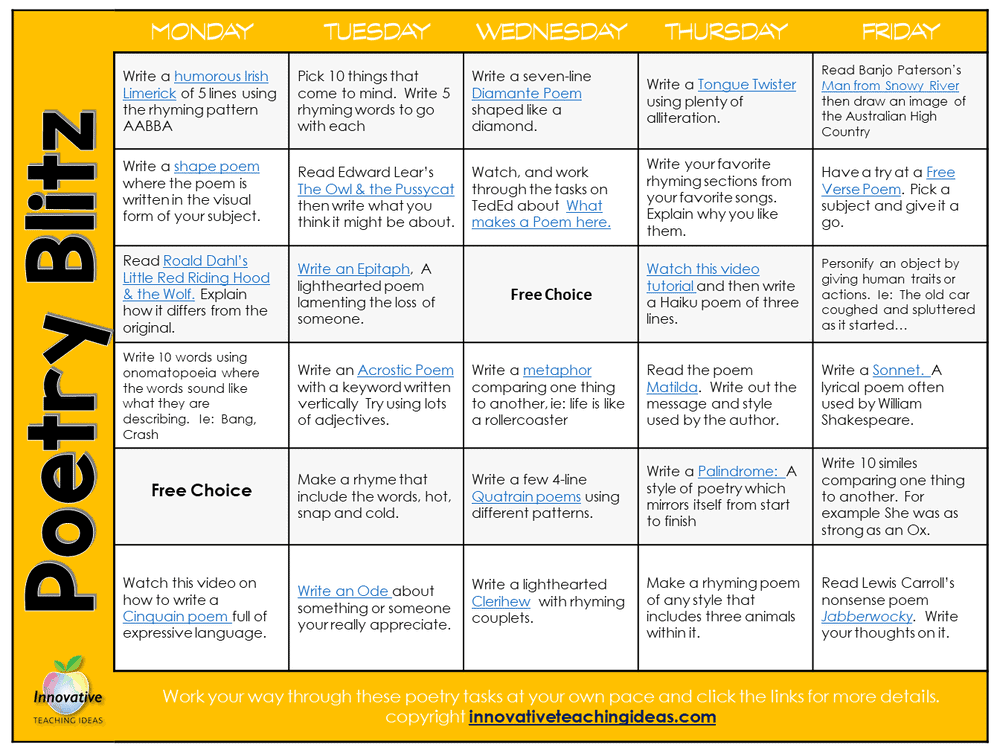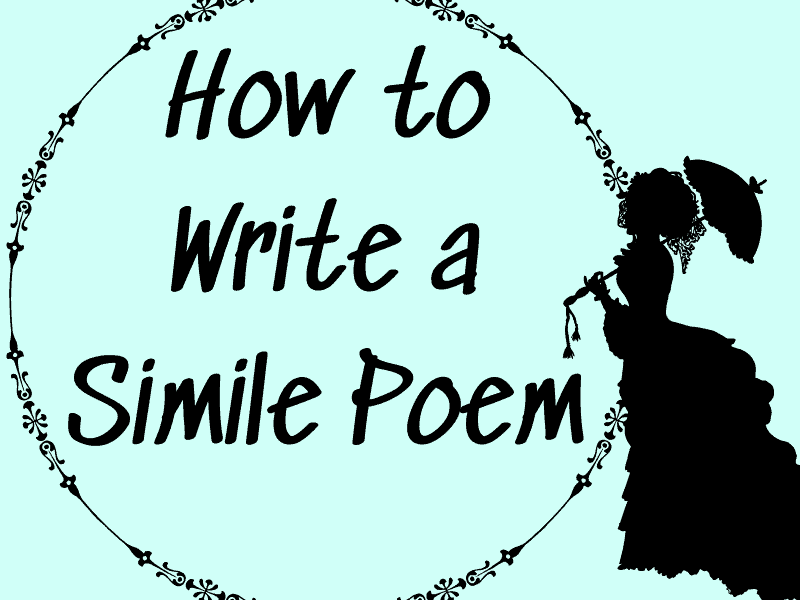Think About the Three Forms of Poetry You Read

Elements of Poesy
WHAT IS A POEM?

Earlier we take a look at some specific elements of verse, it'd be useful to make a brief attempt at defining just what a poem is.
What exactly is it that makes a poem different, for example, to a piece of prose? Or song lyrics, even?
The truth is that when nosotros go down to it poetry isn't all that like shooting fish in a barrel to pivot downward. Even poets themselves disagree about what constitutes a verse form. What chance and so do our struggling students accept?
Luckily, there are some broad, general characteristics that can be agreed upon. In this article, nosotros will expect at these common features of poetry and how we can all-time instil an understanding of these in our students.
Mutual FEATURES OF POETRY
● It looks like a poem – if information technology looks similar a poem and it reads like a poem, then the chances are pretty good that it is, indeed, a poem. Poetry comes in lines, some of which are full sentences, only many of which are not. Besides, usually, these lines don't run out to the margins consistently, like in, say, a novel. All this gives poesy a distinctive and recognisable look on the page.
● Information technology often has some underlying form holding things together – while this isn't always true (in some free verse, for instance) a lot of poetry conforms to a prescribed structure such equally in a sonnet, a haiku etc.
● It uses imagery – if the poet is worth his or her salt, they'll try to create images in the reader'due south mind using lots of sensory details and figurative language.
● Information technology has a certain musicality – we could exist forgiven for thinking that poetry's natural incarnation is the written word and its habitat the page, but the printed word is not where poesy'south origins prevarication. The earliest poems were composed orally and committed to memory. We can all the same meet the importance the audio of language plays when nosotros read poems out loud. We tin see it too in the attention paid to musical devices that are incorporated into the poem. Devices such as alliteration, assonance, and rhyme, for example. We will look at many of these later in this commodity.
THE ULTIMATE GUIDE TO Didactics Verse
Make poetryFUN, ENGAGING, AND RELEVANT! This unit is a consummate solution for instruction and learning poetry to students. ❤️ABSOLUTELY NO PREP REQUIRED ❤️. Just download and start instruction.
THE PURPOSE OF Poesy: WHAT IS POETRY FOR?
Of all the forms professional person writers tin have, it is the professional person poet who most often finds themself struggling to make ends run across financially. Poetry can be hard to sympathise and require a lot of attempt on the office of the reader. Students can be forgiven for wondering what exactly is the point of this difficult to write and difficult to read a genre that is apparently used to torture the less literary-minded during their schoolhouse years.
Information technology may be a difficult sell to some of our more reluctant students, simply there is a signal behind all this word-smithery.
Verse'south purpose is essential to help us sympathize the globe effectually us. It endeavours to testify us things anew that nosotros may take previously taken for granted. It offers us new perspectives on the familiar.
Verse'southward purpose is to enable u.s.a. to see the globe with fresh eyes again, similar those of a child. In doing this, it helps u.s.a. empathise our world in a deeper way.
THE STRUCTURE OF Poetry
We've mentioned already that though poesy'due south origins lie in the spoken word, it does take a very recognizable shape when put down on the page. This is largely due to the overall arrangement of the lines on the page, often in the form of stanzas.
THE STANZA
Though some modern forms of verse eschew traditional poetic conventions such as rhyme schemes and meter etc, the stanza even so plays an important role in the overall look of printed poetry.
Only, just what exactly is a stanza? – your students may well enquire.
Stanzas are basically the poetic equivalent of a prose paragraph. They are a series of lines that are grouped together and separated from other groups of lines or stanzas by a skipped line.
Stanzas come in a diversity of lengths, dependent either on the whim of the poet or the conventions of a item poetic form. There is a variety of technical vocabulary oft used to refer to stanzas of specific lengths. Here are the about common of these,
Stanzas of:
● 2 lines are chosen a couplet
● 3 lines are called a tercet
● four lines are called a quatrain
● 5 lines are called a cinquain
● vi lines are called a sestet, or occasionally a sexain
● 7 lines are called a septet
● 8 lines are chosen an octave
Poem STRUCTURES: TYPES OF POETRY AND THEIR CHARACTERISTICS
When exploring the elements of poesy we must appreciate there are many different types of poetry, some of which we will look at below. Simply, regardless of the specific blazon of poetry in question, most likely a poem will fit into i of these three overarching types of poetry: lyric, narrative, and descriptive.
Lyric Poetry
Lyric verse concerns itself largely with the emotional life of the poet, that is, it's written in their voice and expresses strong thoughts and emotions. There is simply one voice in a lyric poem and we run into the world from that single perspective. Virtually modern poetry is lyric poetry in that information technology is personal and introspective.
Narrative Poetry
As its name implies, narrative poesy is concerned with storytelling. Just as in a prose story, a narrative poem volition most likely follow the conventions of plot including elements such as conflict, rising action, climax, resolution etc. Again, as in prose stories, narrative poems volition most probable be peopled with characters to perform the deportment of the tale.

Descriptive Poetry
Descriptive poetry normally employs lots of rich imagery to describe the earth around the poet. While information technology almost often has a unmarried poetic voice and strong emotional content, descriptive poetry differs from lyric poetry in that its focus is more than on the externalities of the world, rather than the interior life of the poet.
We have mentioned that poetry often hangs on the conventions of specific underlying structures. Let'due south now take a expect at some of the more common of these subtypes and their defining characteristics.
SUBTYPES OF Poesy
Sonnet
Sonnets are predominantly concerned with matters of the centre. If you encounter a sonnet'southward recognisably blocky form on a folio, there's a good hazard the theme volition be love. At that place are two mutual forms of sonnet: Shakespearean and Petrarchan. They differ slightly in their internal construction, just both have 14 lines. Let's take expect at some more of the internal characteristics of both forms:
Petrarchan
● Comprises 2 stanzas
● The Kickoff 8 lines pose a question
● second stanza answers the question posed
● The rhyme scheme is: ABBA, ABBA, CDECDE
Shakespearean
● Comprises 3 quatrains of iv lines each
● Ends with a rhyming couplet which forms a decision
● The rhyme scheme is: ABAB, CDCD, EFEF, GG
Haiku
Haiku is a disciplined form of poetry that has its origins in 17th-century Japanese poesy. Usually, it is concerned with nature and natural phenomena such as the seasons, weather etc. They are often quite meditative in tone.
However, at that place are no real rules regarding themes, the only existent demands here relate to structure:
● They are written in three-line stanzas
● 1st line contains 5 syllables
● 2nd line contains seven syllables
● tertiary line contains five syllables
Due to their short length and express requirements, these are usually a lot of fun for students to write. They can serve every bit a bang-up introduction for students to endeavor to write verse according to specific technical requirements of a class.

Elegy
Elegies are a type of poem that don't really come with specific structural requirements but withal constitute a recognisable class of poetry. What makes an elegy an elegy is its subject, that is, death. Elegies are poems of lamentation – the word elegy itself comes from the Greek discussion elegeia which ways to 'lament'.
● A poem of reflection on death, or on someone who has died
● Usually comes in three parts expressing loss:
○ grief
○ praise for the deceased
○ and, finally, consolation.
Limerick
Favorites of schoolhouse children everywhere, the most defining characteristic of limericks are their renowned humour. Given their well-deserved reputation for being funny and, on occasion, rough, information technology'southward easy to overlook the fact that below the laughs prevarication quite a tightly structured verse class.
● 5 lines in full
● Singled-out verbal rhythm
● two longer lines of usually betwixt 7 to x syllables
● 2 shorter lines of normally between 5 to 7 syllables
● one endmost line containing the 'punchline'
● Rhyme scheme is AABBA
Ballad
Ballads are a type of narrative poesy that has shut ties to musical forms. Ballads written as poetry tin can often easily be adapted as song lyrics. While ballads don't have tight formal constrictions like some other forms of poesy, there are enough in the style of distinguishable features to place it as a class.
● Tells a story, frequently using simple language
● Frequently romantic, audacious, or humorous
● Bundled in groups of four lines or quatrains
● Often uses alternating 4 and 3 beat lines
● Rhyme scheme is usually ABAB or ABCB
Ode
Some other poesy form that traces its origins to Ancient Greece, odes were originally intended to exist sung. Nowadays, though no longer sung, the term ode still refers to a type of lyrical verse form that addresses and ofttimes praises a certain person, thing, or consequence.
● The writer addresses a person, thing, or event
● Usually has a solemn, serious tone
● Explores universal elements of the theme
● Powerful emotional element, often involving catharsis
Odes written in the classical vein tin follow very strict metrical patterns and rhyme schemes, still, many modern odes are written in gratuitous verse involving irregular rhythm and without adherence to a rhyme scheme.
Epic
These are long narrative poems that recount heroic tales, ordinarily focused on a legendary or mythical figure. Recollect of works of literature on a grand scale such as The Odyssey, The Cattle Raid of Cooley, or Beowulf.
● Employs an objective and omniscient narrator
● Written in an elevated style
● Recounts heroic events
● Grand in scale
POETIC DEVICES
Though we refer to these devices here as 'poetic devices', the devices below are not the exclusive domain of poetry lone. Many of these are to be found in other writing genres too, particularly other creative forms such every bit short stories, novels, and creative nonfiction.
Many of these devices have their origins in verse's roots equally a spoken literary form. They rely on the musicality of words; their rhythm and rhyme. They focus on various sound effects that tin be created by the carefully called word.
Other devices are more concerned with imagery. They forge connections between diverse ideas and conjure pictures in the minds of the readers. Together, these devices elevator poetry into the realm of art.
The following devices are organized into two sections. The kickoff section titled Sound Devices deals with the post-obit devices: alliteration, assonance, consonance, onomatopoeia, rhyme, and rhythm.
The 2d department Figurative Linguistic communication deals with metaphor, personification, and simile. These are non meant as an exhaustive listing, but to give an indication of the possibilities for these elements of poetry. Y'all can notice many more examples of these in our article on figurative language.
Students will do good from learning the definitions of each of these devices over time. While it is important that they larn to recognize their use in the poetry of others and to learn to appreciate the furnishings these devices can create, it is as important that the students get a chance to accept a go at creating their own examples of these devices in their own writing.
It is merely by trying their hand at employing these devices in their own piece of work that students can really internalize how these devices operate. So, in the section below nosotros'll first look at a working definition of the poetic device, then an example to illustrate it in action, before offer a simple exercise students can undertake to gain more than practice with it themselves.

SOUND DEVICES
Alliteration
Meaning: This device involves the repetition of the initial consonant sound of a serial of words, oftentimes consecutively. Ingemination is most hands explained to students through looking at a few unproblematic tongue twisters, such as Peter Piper or She Sells Seashells.
Instance:
Betty Botter bought a fleck of butter
Only, the bit of butter Betty Botter bought was biting
Then Betty Botter bought a ameliorate bit of butter
Do: Challenge the students to write their own tongue twisters using alliteration. Y'all may wish to give them a topic to write on to get started. For example, younger students may well relish writing about animals. They may even wish to employ the sounds animals make in their tongue twister e.yard. The slithering snake slid sideways through the grass… Once they have written their poem see if they tin identify any other elements of poetry inside it.
Assonance
Meaning: Similarly to alliteration, assonance involves the repetition of sounds in a series of words, often consecutive words. However, rather than repeating the initial sounds, assonance focuses on the internal vowel sounds that are repeated.
Instance:
We tin can observe many examples of assonance in poetry and song. Here's an instance from the poetry of Edgar Allen Poe: Hear the mellow wedding bells
Exercise: Assonance is ofttimes referred to as 'vowel rhyme'. It is very common in many forms of pop music, especially rap. Claiming your students to detect examples of assonance in the music they heed to and share them with the class. They may also desire to try their paw at writing their own examples besides.
Consonance
Meaning: Consonance is the consonant-focused counterpart to assonance. Information technology involves the repetition of consonant sounds in the middle or at the end of words, equally distinguished from alliteration where the initial audio is repeated.
Example: The crow struck through the thick deject like a rocket
Practise: As there are lots of similarities between the devices alliteration, assonance, and consonance, it would be a skillful idea to requite the students opportunities to practice distinguishing betwixt them. A good exercise to achieve this is to have them first identify examples of each device from a verse in a poesy anthology, earlier challenging them to come up upward with original examples of each on their own. The students tin then use the examples they accept identified every bit models to create their own.
Onomatopoeia

Meaning: Onomatopoeia refers to the procedure of creating words that sound like the very affair they refer to. For many students, the first introduction to onomatopoeia goes back to learning animal sounds as an infant. Words such as Oink! Chirp! Woof! and Meow! can all be thought of as onomatopoeic. Exist sure to examine these elements of poetry with your younger students starting time.
Example: Aside from animate being noises, the names of sounds themselves are oftentimes onomatopoeic, for instance:
Blindside!
Thud!
Crash!
Exercise: Encourage students to money new onomatopoeic words. Instruct them to sit in silence for a few minutes. They should pay shut attention to all the sounds they can hear in the environment. When the time is upwards, have the students speedily jot down all the noises they heard. They should then come up with an onomatopoeic give-and-take for each of the different sounds. For instance, if they could hear people indistinctly talking in the corridor they might come up with the word 'rabbalabba' to draw the sound they heard. Every bit an extension, they could then try to utilize their freshly-minted words in sentences.
Rhyme
Meaning: Rhyme refers to the repetition of sounds in a verse form. Various types of rhyme are possible, still in English we usually use the term rhyme to refer to the repetition of the final sounds in a line, or end rhyme. Letters are often used to denote a rhyme scheme. A new letter is ascribed to each of the different sounds. For example, in the following case the rhyme scheme is described as ABAB.
Example:
The people along the sand
All plow and look one way.
They turn their back on the land.
They look at the sea all twenty-four hour period.
[From Neither Out Far Nor In Deep by Robert Frost]
Practise: Even though a lot of modern poesy no longer follows a strict rhyme scheme, it is nonetheless helpful for students to be able to recognize various rhyming patterns in poetry. A good way for them to gain more than feel with rhyme schemes is to requite them copies of several different poems and ask them to describe the rhyme scheme using letters eastward.g. ABAB, ABABCC etc. Once they have completed this chore, they tin then be challenged to write a stanza or two of poetry employing each rhyme scheme identified.
Rhythm
Meaning: Rhythm in verse involves audio patterning. A lot of classical poetry conforms to a systematic regularity of rhythm which is referred to as the poem'due south meter. This involves the combining of stressed and unstressed syllables to create a constant trounce pattern that runs throughout the verse form. Each design of beats is called a foot. In that location are various possible combinations of stressed and unstressed syllables, or feet, and these patterns have their own names to draw them. While it is impossible to explore all of these in this article, we have a expect at i of the more mutual ones below.
Example:
Shall I com skin thee to a sum mer's twenty-four hour period
[Iambic pentameter i.e. five metrical feet of alternating unstressed and stressed syllables]
Exercise: A useful mode of tuning in students to meter is to have them mark the stressed and unstressed syllables in a line of poetry. The iambic pentameter is a good place to start. This pattern is establish in many of Shakespeare's plays. Information technology is also frequently used in beloved sonnets where its rhythm is thought to reflect the beating of the human heart and reinforce the thought that honey comes 'from the middle'. Once students take become skilful at recognizing various meters and rhythms, they should have a get at writing in them too.
Figurative / Connotative Linguistic communication in Verse
Metaphor
Meaning: Metaphors make comparisons between things past stating that one affair literally is something else. Metaphors are used to bring clarity to ideas by forming connections. Often, metaphors reveal implicit similarities between two things or concepts.
Example: We tin can observe lots of examples of metaphors in our everyday spoken language, for case:
She'due south an old flame
Time is money
Life is a rollercoaster
Exercise: When students can comfortably identify metaphors in the poems of others, they should try their hands at creating their ain metaphors. A good place to offset is past challenging them to convert some similes into metaphors. Not merely does this requite students valuable practice in creating metaphors, it helps reinforce their agreement of the differences between metaphors and similes while giving them a scaffold to support their outset attempts at producing metaphors themselves.
Simile
Meaning: Unlike metaphors that make comparisons past saying i thing is something else, similes work by saying something is similar to something else. They commonly come in two forms. Those that make a comparison using 'every bit' and those that brand a comparing using 'similar'.
Instance:
She is as strong every bit an ox
She sings like a nightingale
Exercise: Equally with the exercise for metaphors, information technology'd be useful practice for students to convert metaphors they identify in verse into similes, reinforcing their understanding of both in the process.
Personification
Pregnant: Personification is a particular type of metaphor where a non-human affair or idea is ascribed human being qualities or abilities. This tin be in the class of a single phrase or line, or extended in the course of a stanza or the whole poem.
Example:
The moon was shining sulkily,
Because she thought the sun
Had got no business organization to be there
After the solar day was done –
"It'due south very rude of him," she said,
"To come and spoil the fun."
[From the Walrus and the Carpenter by Lewis Carroll]
Practise: To help students practice distinguishing between metaphors, similes, and personification, gather a listing of jumbled up examples of each from various poems. Students can then sort these accordingly. When they have completed this, job them to come with an original example of each.
The elements of poesy are many and while the elements explored above represent the about important of these, it is not an exhaustive list of every element. It takes lots of exposure for students to become comfy recognizing each and confident employing these elements in their ain writing.
Take every opportunity to reinforce student understanding of these elements. Poetic elements are often employed in genres outside of poetry such as in stories, advertising, and song – waste no opportunity!
DOWNLOAD THIS FREE 30 Mean solar day Verse WRITING ACTIVITY MATRIX

Your students will beloved this 30-day Verse Matrix to challenge their agreement of and ability to write bang-up poetry. It works beautifully for Distance LEARNING due to its instructional hyperlinks and simple guides for students to follow. Add together it to GOOGLE CLASSROOM or SeeSaw to keep your students engaged on the chore.
TUTORIAL VIDEOS ON THE ELEMENTS OF POETRY
LOOKING FOR More Great ARTICLES ON THE ELEMENTS OF Poesy?

Content for this page has been written by Shane Mac Donnchaidh. A former master of an international school and academy English lecturer with 15 years of education and assistants experience. Shane's latest Book the Complete Guide to Nonfiction Writing can be constitute here. Editing and support for this article accept been provided past the literacyideas squad.
Source: https://literacyideas.com/elements-of-poetry/



Post a Comment for "Think About the Three Forms of Poetry You Read"